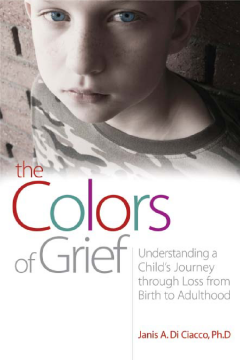
Additional Information
Book Details
Abstract
Following a life shattering experience, a child enters upon a confusing emotional journey that can be likened to a prism of many colors of dark feelings like sadness and fear, but also warm feelings of love and courage. The way they deal with these feelings has a lasting impact on their life as they grow.
The Colors of Grief explores strategies for supporting a grieving child to ensure a healthy growth into adulthood. Drawing on the latest research in neurology and psychology, Janis Di Ciacco illustrates the child's grieving process using a model of development that employs 'key stages'. These range from preverbal infancy (0-2 years) through to early adulthood (about 25 years). She shows how a child's progress through these stages can be impaired by an early encounter with loss, which can contribute to cognitive, emotional and social difficulties. Drawing connections between bereavement, attachment issues and social dysfunction, the author suggests easy-to-use activities for intervention at each key stage, including infant massage, aromatherapy and storytelling.
This is a revealing and accessible book for both parents and professionals working with, or caring for, bereaved infants, children or young adults.
Janis Di Ciacco, PhD has a Master's Degree in Special Education, a Diplôme Linguistique from the Université de Besançon and a Doctorate in Psychology from the University of Denver. She is a licensed clinical psychologist and a certified school psychologist. For the past 30 years, Dr. Di Ciacco has worked with children and their families around issues of attachment and loss, death and dying, foster placement and adoption, post-traumatic stress disorder, fetal alcohol spectrum disorder, autism / Asperger's, and pediatric brain injury. She is also founder of Mindful Moods, LLC, dedicated to the creation of preverbal emotional tools for children and adults and is the creator of the Mood Patch. Dr. Di Ciacco regularly gives seminars and presentations for parents and professionals throughout the US.
Table of Contents
| Section Title | Page | Action | Price |
|---|---|---|---|
| Tables, boxes, and figures | |||
| Acknowledgements | |||
| Preface | |||
| 1. An Islamic prism of poverty | |||
| 2. The Islamic social sector (zakat and waqf) and development: principles, status, and prospects | |||
| 3. The importance of spiritual capital within human development in Islamic teaching | |||
| 4. Translating faith into development: how do Islamic teachings advocate helping the poor? | |||
| 5. Islamic perspectives on refugees, asylum, and forced migration | |||
| 6. Gender and Islam | |||
| 7. Deconstructing Islamic perspectives on sexual and gender-based violence towards a faith-inclusive approach | |||
| 8. Child protection and safeguarding in an Islamic context: understanding the critical role faith plays in supporting protective mechanisms in humanitarian action | |||
| 9. An Islamic approach to peacebuilding: putting theory into practice | |||
| 10. Walking gently on the Earth: Islamic environmentalism and Muslim FBOs | |||
| Index |
